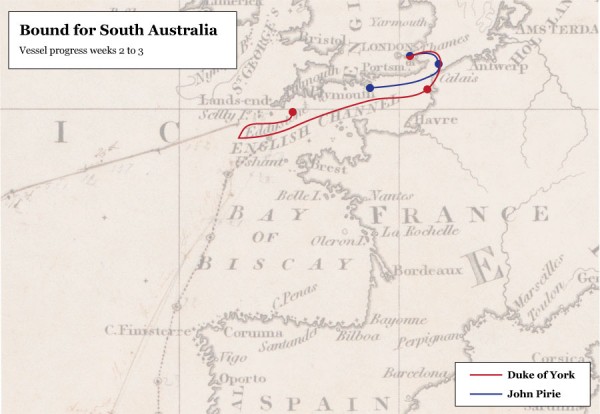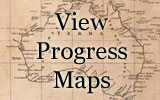As February 1836 drew to a close two of the three South Australian Company ships, the John Pirie and the Duke of York, left Gravesend at the mouth of the Thames and began their careful navigation of the English Channel towards the Atlantic Ocean. Poor Captain Morgan continued to be very anxious about his wife, who was due to give birth any time. He hoped desperately that both she and their child would survive the’trying hour'(Labour, childbirth) and that their existing child would not be left motherless. But very soon he had other worries. The Channel was a capricious stretch of water at the best of times and this was no exception. Overnight on 29 February (1836 was a leap year) both ships were caught in a ferocious storm. With waves breaking over the deck, the vessel ‘very laboursome’ and all the passengers sick, Captain Morgan ran for the shelter of the Isle of Wight, where the Duke of York rode out the rest of the storm secured by two anchors. John Pirie was not so lucky as the following extracts make clear. The author of this account is unknown, although he seems to have been a crew member, responsible for the vessel’s livestock. Read on to discover how these two vessels, their suffering passengers and their animals, fared in the storm.



I’m over-awed by the stoicism of these people – where has our dedication gone today and why do we whinge so much at the smallest displeaure.
And this has only got them to the Isle of Wight – what must lay before them?
Hi Kirsty,
yes that’s him 🙂
Great stuff, our family arrived in SA from the UK only 30 years ago, but I have a passion for stories of sea voyages. (Essential reading for all Australians is, I think, the amazing book by Diane Armstrong – “The Voyage of their Life”. I really recommend it.) but I like this week by week account.
This sort of educational subject is well over due, i am a one eyed South australian , so looking foward to every week. thank you
Regards W.R. Opie
Henry Alford – passenger on the “John Pirie” one of the first policemen in SA and at one time Second Inspector of the Mounted Police. We also had word that he was the person responsible for introducing the white horses for the Parades (instead of the traditional colour) – which are still used to this day. Also, the small township north of Adelaide (near Kadina, Moonta etc.) called ALFORD, is named after him. We heard that he gave chase on horseback and finally captured the criminal in that now known township ALFORD. There is also a painting in the Mortlock Library of Henry Alford, sitting on his horse in his uniform.
Hi Julie,
Many thanks for alerting us to the Henry Alford portrait in the Mortlock Library. Is it this one that appears to have been digitised on the SLSA catalogue? http://images.slsa.sa.gov.au/mpcimg/56000/B55788.htm
Regards,
Kristy – History SA.
I have often wondered what it was like for the people, especially the women, who arrived in South Australia in late December 1836, with dark and voluminous clothing, no refrigeration/air-conditioning, no public transport and bushland where we now see roads, etc. The trip here must have been horrendous. It’s hard to believe that it took so long just to reach the open sea. We’re into the second week and they haven’t left the Channel yet!
Sailors certainly had a tough life. No wonder my great-grandfather jumped ship and settled down to a life on the land!
“took boat and went to cows”
Rather than livestock, it is far more likely that he is referring to the port town of Cowes on the Isle of Wight.
Hi Alan, yes you are correct. He was meaning Cowes on the Isle of Wight (you will note we have these listed in the related places tags at the bottom of the page). We are reproducing excerpts from the original journals word for word and ‘cows’ is what the John Pirie writer penned. Some of the spelling (and handwriting) is quite a challenge to decipher!
If you are interested we have written a little piece on the sources that explains this a bit better:
http://boundforsouthaustralia.history.sa.gov.au/using-this-site/source-material.html
Regards, Kristy – History SA.
This is the way to make the journey by sharing the experiences of the time line. At the moment I’m gazing over Nepean Bay K.I .and steeling myself for the 45 minutes choppy journey back to the mainland. The detailed information is great and portrays the incredible fortitude of the Settlers.
Crikey! I’m exhausted and we haven’t got to the Bay of Biscay yet. I wonder what condition I’ll be in after another 44 weeks of sailing? They were a lot tougher than we are today. I’ll pause here to go below and get my sou-wester, storm cape and sea boots for the next p[art of the trip. Well done!
Keep it coming, I am captivated & am looking forward to the next chapter.
I am looking forward over the next few months and following the voyage of these Free Settlers on the long hard Journey of the first free Settlers to ad,d the hardships they endured , My Great Great Grandfather came here in 1836 on board the Afrcaine
This is a fascinating way to follow these journeys. My Great, Great, Great, Great Grandparents and their family also came on the Africaine, along with the the man who only 3 years later married their daughter, so my 3 Greats Grandparents were on this difficult voyage too. The presentation of this material is fabulous and I am looking forward to the unfolding story each week.